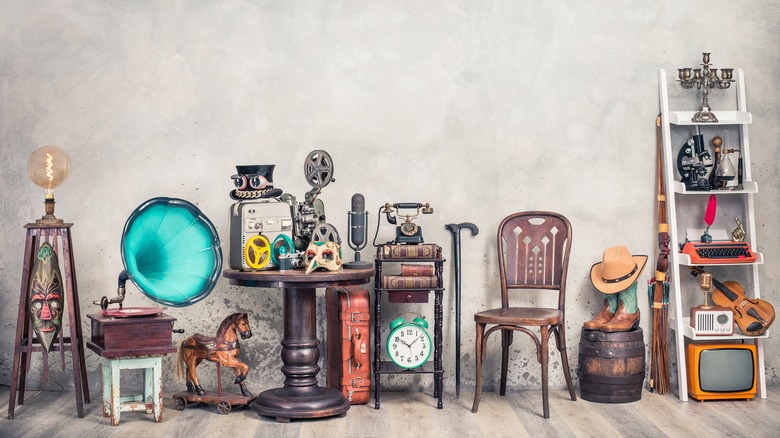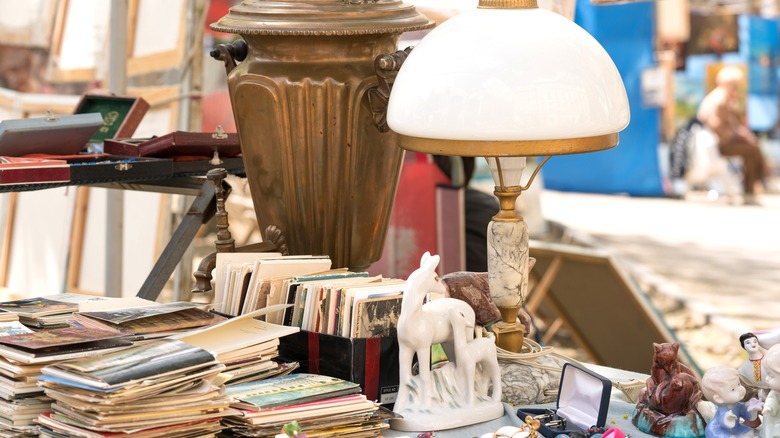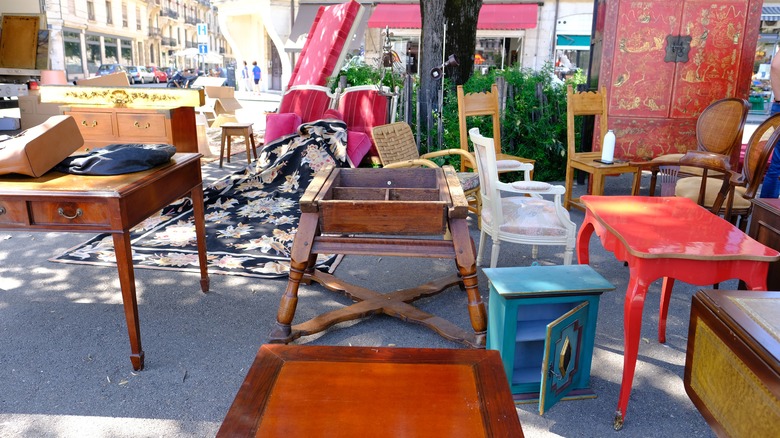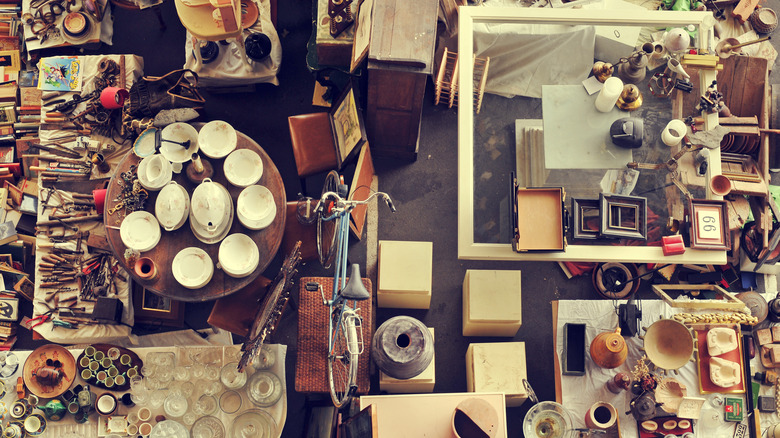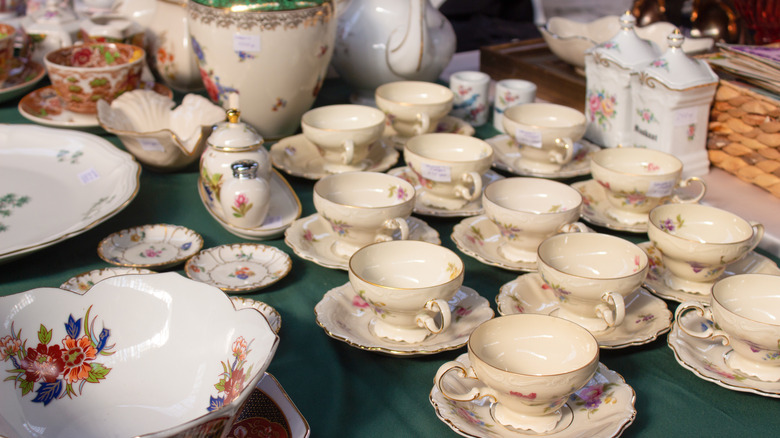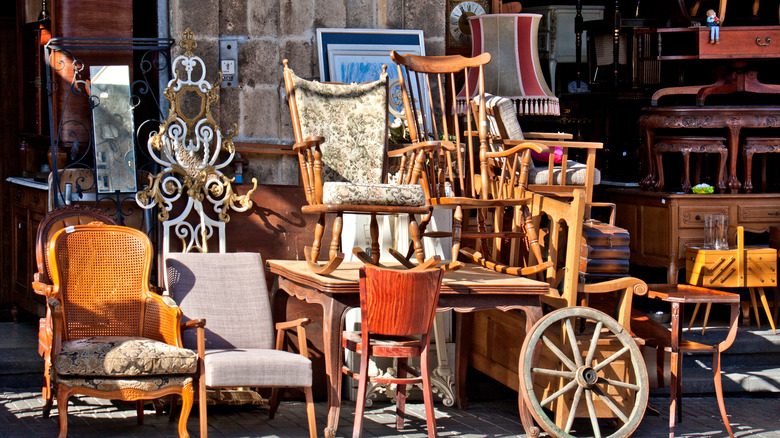5 Mistakes To Avoid When Shopping For Home Decor At A Flea Market
Flea markets can often be a homeowner's treasure trove, providing an enormous selection of items that take our decor to the next level. Whether it's rare antiques at a steal or everyday items from the past that can find a new home and use, flea market shopping is one of the best ways to find exactly what's missing, or what you may not even know you needed, for your home. Flea market style, an eclectic genre that incorporates vintage, antique, and upcycled decor, is even an aesthetic in and of itself (via Grace in My Space)
While flea markets come in a number of sizes and scales, and vary in location from huge indoor pavilions to outdoor parking lots, there are a number of things to consider when planning a trip to the flea market, as well as many ways you can fail to optimize your experience for best results. By planning ahead and keeping a few things in mind as you peruse, you can make any flea market adventure a fruitful and productive one.
1. Not planning ahead
Any flea market shopping expedition can benefit from a little planning in advance. Markets come in a variety of types, from weekend outdoor markets filled with glorious antiques to 365-days-a-year shopping centers filled with a mix of second-hand finds, import items, and discounted electronics. Some markets specialize in particular areas like furniture or vintage clothing.
A little research into what kind of vendors sell at any market and their specialties goes a long way toward helping you find what you want. Everyday considerations like weather, clothing choices, and making sure you have access to snacks and water for long shopping adventures are a must. As are bringing along bags, totes, and maybe a friend to help carry or move larger items. A day has been known to be ruined by poor footwear choices and inclement weather.
According to My 100 Year Old Home, cash is always a good idea as well, since not all vendors have credit machines or apps available, or may be willing to cut a better deal with cash in hand. While many markets do have ATMs nearby, they aren't always in working order when you need them to be. Using cash will also help you stay within a budget if needed.
2. Not having a strategy
As Refresh Living explains, one of the best ways to make sure your flea market endeavors are fruitful is to have a plan going in on what you might be looking for, whether that's larger furniture items for the home or smaller decor and accent pieces. If you're looking for a new mid-century dresser, browsing internet sites like eBay and Worthpoint may help you get a sense of what you're looking for and what you might expect to pay. Nothing hurts quite as much as finding out you paid an exorbitant price for something that could be had much cheaper.
But there's also a danger in having too much of a plan. If you spend too much time looking for a specific thing, you may miss some other wonderful discoveries that would work just as well, or even better than what you were initially looking for. There's something to be said of the thrill of the hunt, but more to be said of serendipitous finds you didn't know you were looking for. A piece of artwork or a vintage lamp may not be what you came seeking, but you'll love taking them home.
3. Not measuring
One of the biggest challenges in flea market shopping is a purely physical one. So often flea markets expose us to beautiful pieces like large mirrors, armoires, dining tables, and setees — all of which may be perfect additions to our homes but are quite large and heavy. A great way to plan ahead is to measure your available space and come up with maximum and minimum dimension requirements for whatever you're looking for. When considering an item, measure it yourself with a trusty tape measure before making the purchase. This is crucial for larger, bulky items you don't want to get home and find out your mistake, but also smaller items that benefit from similar considerations like mirrors and artwork.
According to Woman's Day, it doesn't hurt to measure everything twice to eliminate error. Keep in mind the weight of the item and your ability to transport it. While some vendors will gladly help you carry things to your car, others are unable or unwilling. Having a friend or two along will help, especially when you get home, but also consider the size of your car and whether it might be a good idea to enlist someone with a larger vehicle or rent a van/truck for something like a sofa or sideboard.
4. Not asking questions
While introverts may shy away from too much social interaction, asking questions is welcomed and encouraged at most flea markets. This includes asking for more details on an item's history (if known) or trying to work out a sweet deal. Many vendors have boundaries about how much of a discount or deal they're willing to offer, but it never hurts to ask for a lower price or bulk discount if you're buying multiple things from a single booth. Remember, however, to be cordial whatever the response. The worst they can say is no (via DIY Inspired).
Asking questions may also help you avoid a damaged purchase at full price. Sometimes, sellers will also be willing to negotiate purchases in surprising ways. For example, if you find yourself faced with a set of 12 teacups but only want four, ask if it's possible to only purchase those. While some vendors would be loathed to break up a set, others might be willing to sell a partial set versus nothing at all. By building a rapport with vendors, you might learn something interesting about your purchase or a good story on its discovery. You may also form a connection with a particular vendor, who if you trade contact info, may bode well for future buying and goodwill.
5. Not considering timing
According to Money Crashers, people are usually of two minds regarding the best time to shop at a flea market. The "early bird gets the worm" saying demands that you hit the ground running to get the best goods, as well as offer ample time for shopping before the crowds increase, usually around midday. This is a particularly useful strategy if you know what your looking for is rare or in high demand. Many vendors have social media followings and give sneak peeks before market day, which means shoppers often turn up immediately. In the morning, you're most likely to have the best selection but may end up paying the asking price.
The other school of thought is that late-day shopping is best, particularly during the final hours of a multi-day event. This is the best time to strike a deal since many vendors are looking to unload just a bit more inventory before packing up and heading home. Many might be willing to part with really great things that remain at a considerably lower-than-the-initial-asking price. This strategy works particularly well if you're shopping with more open-ended plans and discover something wonderful last minute. If you happen to spot a great piece early in the day, it may help to circle back one final time to see if the price has changed or if you can reach an agreement on a lower sale.
